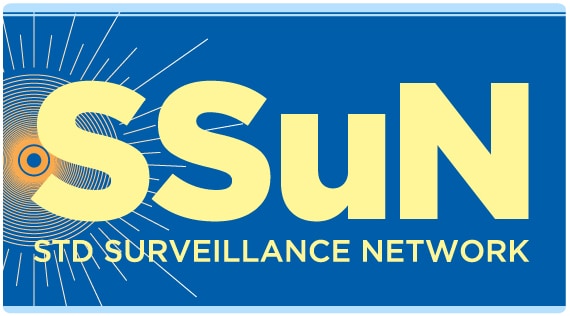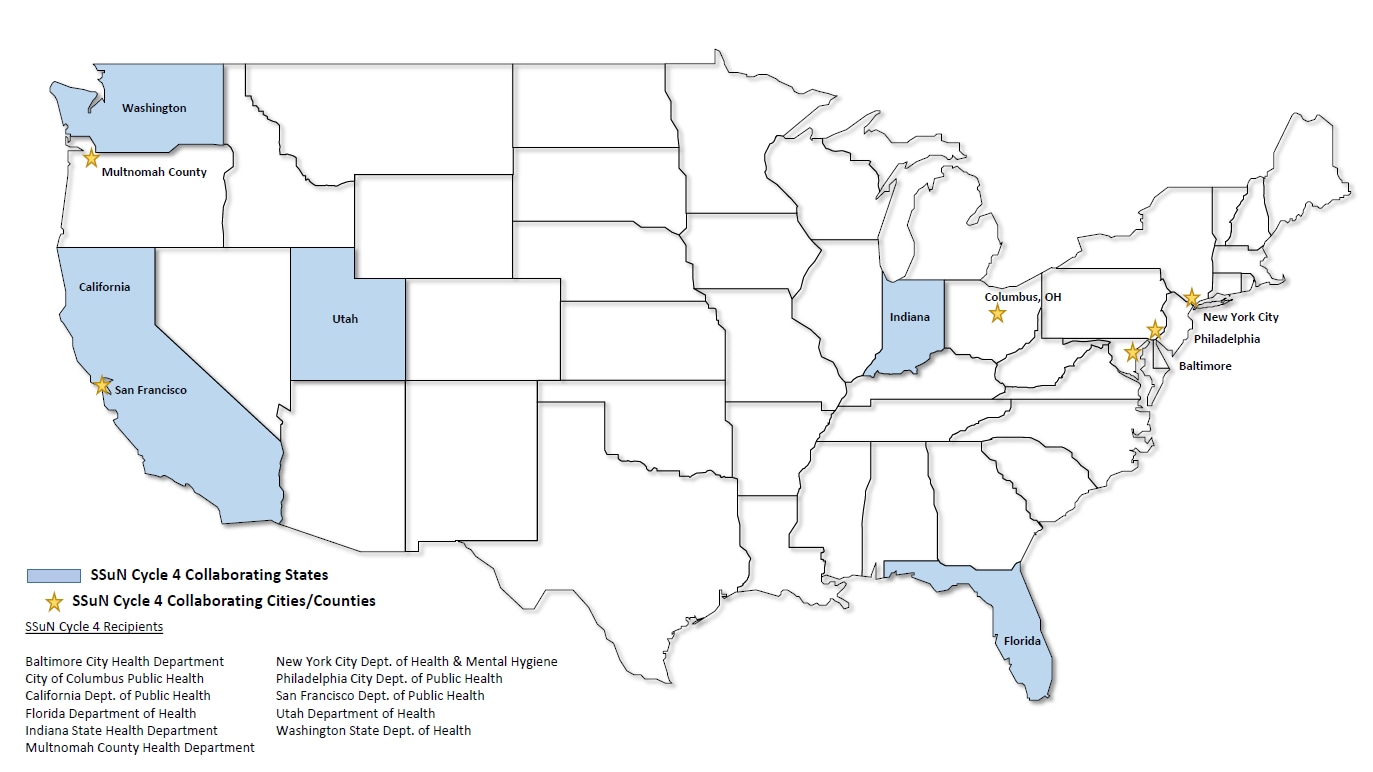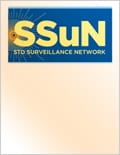STD Surveillance Network (SSuN)

Overview
The purpose of the STD Surveillance Network (SSuN) is to:
- Provide enhanced behavioral, demographic, and clinical information on gonorrhea cases reported to state and local health departments
- Provide information on patients presenting for care in specialty STD clinical settings, and
- Explore innovative strategies to improve STD surveillance nationwide
This information allows CDC and state and local health departments to better understand the epidemiology of STDs nationally and locally. This can inform national and local STD prevention efforts, including important initiatives designed to reduce HIV co-infection among persons diagnosed with STDs.
SSuN is a collaboration of competitively selected state, county, and city health departments, funded to address STD surveillance problems of national, state, and local interest. Established in 2005, SSuN is currently in the fourth cycle. The current cooperative agreement for activities ongoing through 2024 is CDC-RFA-PS19-1907external icon. There are three (two core and one optional) SSuN surveillance strategies, each addressing different methods of enhanced STD surveillance.
Strategy A of SSuN Cycle 4 provides support for selected health departments to implement sentinel surveillance in specialty STD clinics. Funded sites gather information on patient visits, including STD/HIV tests performed at the visit, test results, diagnoses received, and demographic and selected behavioral characteristics of the patients. Sentinel surveillance provides evidence of trends in patients seeking care, trends in provider testing and treatment practices, changes in the number and proportion of patients diagnosed with STDs and HIV co-infection, and uptake of prevention measures such as pre-exposure prophylaxis (PrEP).
Strategy B of SSuN Cycle 4 collects enhanced information on all reported cases of gonorrhea and syphilis. This includes information on laboratory results, treatment, and outcomes from routine partner services interviews. Additionally, all funded sites randomly sample reported gonorrhea cases in their jurisdictions for enhanced clinical, treatment, and behavioral investigations. This provides a probability sample of cases that are weighted to represent all reported cases in the participating sites. Enhanced investigations provide valuable information on gender of sex partners and HIV prevention measures, such as PrEP.
HIV Surveillance Registry Matching: All patients attending participating specialty STD clinics in Strategy A, as well as all reported gonorrhea and syphilis cases in Strategy B, are matched against the sites’ HIV surveillance registry. This allows for analysis of HIV prevalence among persons diagnosed and reported with selected STDs and among persons seeking care in specialty STD clinics.
Strategy C of SSuN Cycle 4 provides resources to support small-scale, time-limited, single- or multi-site projects designed to enhance local surveillance capacity or to investigate issues of specific concern to STD epidemiology. Examples of recent Strategy C activities include:
- modifying local surveillance information systems to report all STD cases in an HL7-compliant format to CDC;
- enhanced analysis of local- or multi-site STD surveillance data;
- identification of undiagnosed ocular syphilis in an ophthalmic clinic.
Through this combination of collaborative surveillance activities, SSuN provides comprehensive information to supplement what CDC receives via routine national case reporting. This information provides CDC and collaborating health departments with STD-related healthcare and incidence trends not currently available from any other source.
This page includes additional information about SSuN data collection protocols, participating jurisdictions, recent publications, and contact information for SSuN project officers.
STD Surveillance Network Collaborators
SSuN Cycle 1 Collaborators (2005 – 2008):
- Colorado Department of Public Health and Environment
- Minnesota Department of Health
- New York City Department of Health and Mental Hygiene
- San Francisco Department of Public Health
- Virginia Department of Health
- Washington State Department of Health
SSuN Cycle 2 Collaborators (2009 – 2013)
- Alabama Department of Public Health
- Baltimore City Health Department
- California Department of Public Health/Los Angeles County
- Chicago Department of Public Health
- Colorado Department of Public Health and Environment
- Connecticut Department of Public Health
- Louisiana Department of Health
- New York City Department of Health and Mental Hygiene
- Philadelphia Department of Public Health
- San Francisco Department of Public Health
- Virginia Department of Health
- Washington State Department of Health
SSuN Cycle 3 Collaborators (2014 – 2019)
- Baltimore City Health Department
- California Department of Public Health/Los Angeles County
- Massachusetts Department of Health
- Minnesota Department of Health
- Multnomah County Health Department
- New York City Department of Health and Mental Hygiene
- Philadelphia Department of Public Health
- San Francisco Department of Public Health
- Utah Department of Health
- Washington State Department of Health
Currently Funded SSuN Cycle 4 Collaborators (2019 – 2024)
- Baltimore City Health Department
- California Department of Public Health
- City of Columbus Public Health
- Indiana Department of Health
- Multnomah County Health Department
- New York City Department of Health and Mental Hygiene
- Philadelphia Department of Public Health
- San Francisco Department of Public Health
- Utah Department of Health
- Washington State Department of Health

Click for larger version pdf icon[PDF – 247 KB]
CDC SSuN Contacts
For questions about the STD Surveillance Network and a list of recent publications, please reach out to the SSuN contacts below.
Marvin J. Fleming,
Public Health Advisor, SSuN Project Officer
Enhanced Surveillance and Special Studies Team,
Surveillance and Data Science Branch,
Division of STD Prevention, NCHHSTP
Centers for Disease Control and Prevention
1600 Clifton Road, Mail Stop US12-2
Atlanta, GA 30329-4027
(O) 404.639.8352
mfleming@cdc.gov
Mark R. Stenger, MA
Epidemiologist, Lead Science Officer, SSuN
Enhanced Surveillance and Special Studies Team,
Surveillance and Data Science Branch,
Division of STD Prevention, NCHHSTP
Centers for Disease Control and Prevention
1600 Clifton Road, Mail Stop US12-2
Atlanta, GA 30329-4027
(O) 404-639-6136
(F) 404-639-8610
mstenger@cdc.gov
Lisa Llata, MD, MPH
LCDR, USPHS
Epidemiologist, Medical Science Officer, SSuN
Enhanced Surveillance and Special Studies Team,
Surveillance and Data Science Branch,
Division of STD Prevention, NCHHSTP
Centers for Disease Control and Prevention
1600 Clifton Road, Mail Stop US12-2
Atlanta, GA 30329-4027
(O) 404-639-6183
(F) 404-639-8610
ellata@cdc.gov
